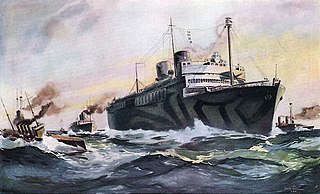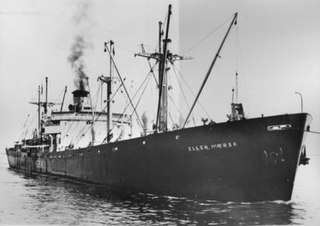North Carolina Shipbuilding Company was a shipyard in Wilmington, North Carolina, created as part of the U.S. Government's Emergency Shipbuilding Program in the early days of World War II. From 1941 through 1946, the company built 243 ships in all, beginning with the Liberty ship SS Zebulon B. Vance, and including 54 ships of the US Navy. Most of the latter were attack cargo ships (AKA), amphibious force flagships (AGC) and ammunition ships (AE). A list of all 54 Navy ships appears at the end of this article, as does a link to a detailed record of all ships built by the company.

USS General J. H. McRae (AP-149) was a General G. O. Squier-class transport ship built for the United States Maritime Commission during World War II. In 1946 she was transferred to the US Army and operated as USAT General J. H. McRae. On 1 March 1950 she was transferred to Military Sea Transportation Service and operated as USNS General J. H. McRae (T-AP-149). She was named for US Army Major General James H. McRae.

USS Siboney (ID-2999) was a United States Navy troopship in World War I. She was the sister ship of USS Orizaba (ID-1536). Launched as SS Oriente, she was soon renamed after Siboney, Cuba, a landing site of United States forces during the Spanish–American War. After her navy service ended, she was SS Siboney for the New York & Cuba Mail Steamship Co.. The ship was operated under charter by American Export Lines beginning in late 1940. During World War II she served the U.S. Army as transport USAT Siboney and as hospital ship USAHS Charles A. Stafford.

SS Munargo was a commercial cargo and passenger ship built for the Munson Steamship Line by New York Shipbuilding Corp., Camden, New Jersey launched 17 September 1921. Munargo operated for the line in the New York-Bahamas-Cuba-Miami service passenger cargo trade. In June 1930 the United States and Mexican soccer teams took passage aboard Munargo from New York to Uruguay for the 1930 FIFA World Cup. The ship was acquired by the War Shipping Administration and immediately purchased by the War Department for service as a troop carrier during World War II. Shortly after acquisition the War Department transferred the ship to the U.S. Navy which commissioned the ship USS Munargo (AP-20). She operated in the Atlantic Ocean for the Navy until returned to the War Department in 1943 for conversion into the Hospital ship USAHS Thistle.
USNS Lt. James E. Robinson (T-AKV-3/T-AG-170/T-AK-274) was a Lt. James E. Robinson-class cargo ship, which was launched as a World War II commercial Victory cargo ship SS Czechoslovakia Victory under the Emergency Shipbuilding program. She had earlier been the U.S. Army's USAT LT. James E. Robinson before being acquired by the U.S. Navy.

SS Edenton was a steel-hulled cargo ship built in 1918 for the United States Shipping Board as part of the Board's World War I emergency shipbuilding program.
SS Robert F. Hoke was a Liberty ship built in the United States during World War II. She was named after Robert Hoke, Confederate Army Major General, politician, and Director of the North Carolina Railroad.
SS Nathanael Greene was a Liberty ship built in the United States during World War II. She was named after Nathanael Greene, Continental Army general famous for his service in the Southern theater of the American Revolutionary War. She was operated by the United States Lines under charter with the Maritime Commission and War Shipping Administration.

SS Virginia Dare was a Liberty ship built in the United States during World War II. She was named after Virginia Dare, the first English child born in America, who disappeared along with the rest of the Roanoke Colony.
SS Joseph Hewes was a Liberty ship built in the United States during World War II. She was named after Joseph Hewes, Secretary of the Naval Affairs in the 2nd Continental Congress and signer of the Declaration of Independence for North Carolina.
SS James J. Pettigrew was a Liberty ship built in the United States during World War II. She was named after J. Johnston Pettigrew, a Confederate general from North Carolina killed during the American Civil War.
SS Daniel H. Hill was a Liberty ship built in the United States during World War II. She was named after Daniel Harvey Hill, a Confederate general who commanded units from North Carolina in the American Civil War.

SS Alexander Lillington was a Liberty ship built in the United States during World War II. She was named after Alexander Lillington, a North Carolina Patriot militia officer who served at the Battle of Moore's Creek Bridge and the Battle of Camden.

SS Furnifold M. Simmons was a Liberty ship built in the United States during World War II. She was named after Furnifold McLendel Simmons, a politician from North Carolina responsible for the disenfranchisement of African-American voters in that state, as well as head of a Democratic Party political machine until his death in 1940.
SS Waigstill Avery was a Liberty ship built in the United States during World War II. She was named after Waightstill Avery, the first Attorney General of North Carolina who fought a duel with Andrew Jackson in 1788.
SS Cornelia P. Spencer was a Liberty ship built in the United States during World War II. She was named after Cornelia Phillips Spencer, an influential writer and journalist in North Carolina during the Reconstruction era.
SS John Owen was a Liberty ship built in the United States during World War II. She was named after John Owen, Governor of North Carolina from 1828 to 1830.

Alice Harper Willson Broughton was an American civic leader who served as the First Lady of North Carolina from 1941 to 1945 as the wife of Governor J. Melville Broughton. She and her husband were the first governor and first lady from Wake County to live in the North Carolina Executive Mansion. During World War II she was active in the war effort, promoting victory gardens across the state and establishing one at the governor's mansion, christening liberty ships including the SS Zebulon B. Vance and the SS Donald W. Bain, and donating rubber to the armed forces.

A. H. Bull Steamship Company was a shipping company and passenger liner service founded in New York City in 1902 by Archibald H. Bull (1848-1920). Service started with shipping between New York and Florida. His fleet of ships then added service to other Eastcoast ports. The company is also often called the Bull Lines and the Bull Steamship Line or A. H. Bull & Company. While founded in New York, Bull soon move its headquarter to Peir 5 in Baltimore, Maryland. Bull Lines main Eastcoast ports were: Baltimore, Charleston, Philadelphia, Tampa and Norfolk, Virginia. Oversea ports: Porto Rico, Antwerp, Bordeaux, Hamburg, Bremen, Copenhagen, and West Africa. Bull Steamship Line supported the US war effort for both World War I and World War II, including the loss of ships.









